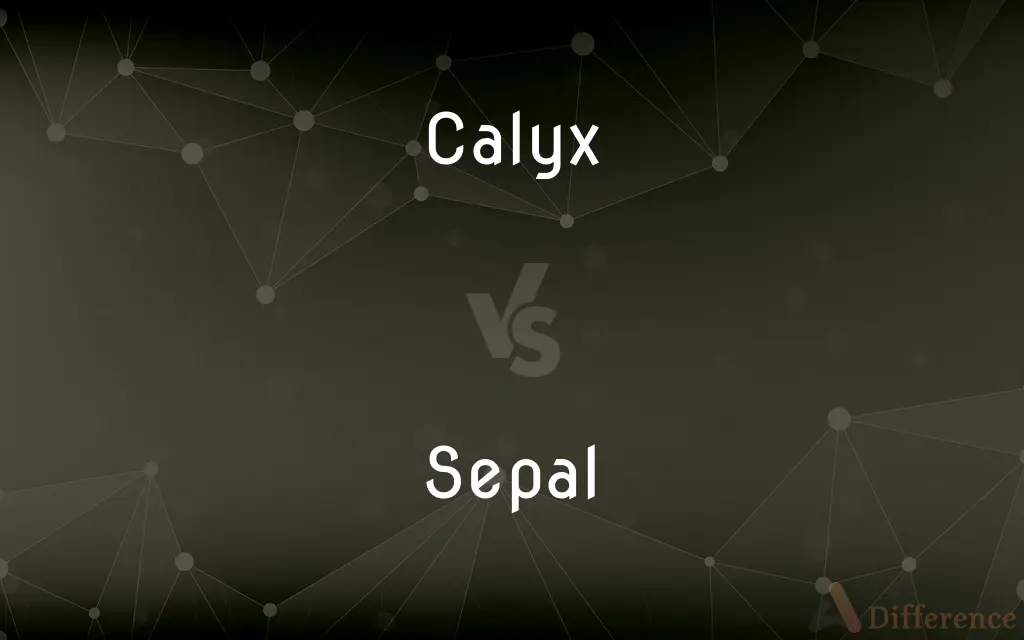Calyx vs. Sepal — What's the Difference?
By Tayyaba Rehman & Urooj Arif — Updated on March 22, 2024
The calyx is the collective term for all the sepals of a flower, forming the outermost whorl that protects the flower bud, whereas a sepal is an individual leaf-like part of the calyx, often green and serving to shield and support the developing bud.

Difference Between Calyx and Sepal
Table of Contents
ADVERTISEMENT
Key Differences
The calyx is an essential part of a flower's anatomy, comprising the entirety of the sepals, which together form the outermost whorl of the flower. Its primary function is to protect the flower in its bud stage and support the bloom as it matures. On the other hand, a sepal is a single unit of the calyx and can be seen as one of the leaf-like structures that make up this protective whorl. Sepals are typically green and resemble leaves, contributing to the photosynthesis process and overall health of the flower.
While the calyx serves as a collective protective cover for the budding flower, each sepal within it has its own role in this protective function. The distinction is similar to that between a team and an individual team member; the calyx represents the whole team, while the sepal is an individual contributing to the team's goal. Conversely, sepals, depending on the flower species, can vary in number, size, shape, and color, contributing to the unique appearance and structure of each calyx.
In terms of botanical significance, the calyx is considered one of the four main floral whorls, with its health and integrity being crucial for the protection and subsequent development of the flower. Sepals, while being components of the calyx, can have individual characteristics and can sometimes be fused together to form a cup-shaped structure, known as a gamosepalous calyx, or remain free as in a polysepalous calyx. This variability in sepal arrangement and structure contributes to the diversity of flower forms and functions.
The appearance of the calyx and its sepals can vary widely among different plant species. In some flowers, the calyx is very prominent and may remain intact even after the flower blooms, while in others, it may wither and fall off once the flower has fully developed. Similarly, sepals can be large and petal-like, contributing to the flower's overall aesthetic, or they can be small and inconspicuous, serving a more strictly protective role.
Despite their functional similarities, the distinction between the calyx and sepals is important for understanding flower anatomy and physiology. The calyx, as a collective structure, plays a critical role in the early stages of a flower's lifecycle, while individual sepals can exhibit a wide range of forms and functions that contribute to the flower's development and the plant's reproductive success.
ADVERTISEMENT
Comparison Chart
Definition
The collective term for all sepals of a flower
An individual part of the calyx
Function
Protects the flower bud and supports the bloom
Contributes to the protection and support of the flower bud
Appearance
Forms the outermost whorl of the flower
Typically green and leaf-like
Variability
Consistency depends on the number and form of sepals
Can vary in size, shape, and color even within a single calyx
Botanical Role
Considered one of the four main floral whorls
Individual units that make up the calyx
Compare with Definitions
Calyx
The collective outer whorl of a flower.
The calyx of the rose bud was just beginning to peel back to reveal the petals inside.
Sepal
A unit of the calyx.
Each sepal of the tulip was carefully examined for signs of disease.
Calyx
Comprised of all sepals.
The flower's calyx, with its vibrant green sepals, provided a stark contrast to its bright red petals.
Sepal
Often green and leaf-like.
The sepals were a deep green, almost indistinguishable from the plant's actual leaves.
Calyx
Varies widely among species.
The unique calyx of the hellebore contributes to its distinct appearance.
Sepal
Can be fused or free.
In this species, the sepals are fused at the base, forming a cup-like structure.
Calyx
Protects developing flowers.
The calyx encased the developing bud, shielding it from environmental stressors.
Sepal
Contributes to the calyx's appearance.
The brightly colored sepals were mistaken for petals by the casual observer.
Calyx
Supports the blooming flower.
As the flower bloomed, the calyx at its base offered unwavering support.
Sepal
Provides bud protection.
The bud was nestled safely within the protective embrace of its sepals.
Calyx
(Anatomy) A cuplike structure, such as the collecting structures into which the pelvis of the kidney is divided.
Sepal
One of the usually green leaflike structures composing the outermost part of a flower. Sepals often enclose and protect the bud and may remain after the fruit forms.
Calyx
(Ecclesiastical) A calix.
Sepal
A sepal ( or ) is a part of the flower of angiosperms (flowering plants). Usually green, sepals typically function as protection for the flower in bud, and often as support for the petals when in bloom.
Calyx
(Botany) The outermost part of a flower, consisting of the sepals.
Sepal
(botany) One of the component parts of the calyx, particularly when the sepals in a plant's calyx are not fused into a single structure.
Calyx
(botany) The outermost whorl of flower parts, comprising the sepals, which covers and protects the petals as they develop.
Sepal
A leaf or division of the calyx.
Calyx
Any of various cup-like structures.
Sepal
One of the green parts that form the calyx of a flower
Calyx
A chamber in the mammalian kidney through which urine passes.
Calyx
The crown containing the viscera of crinoids and similar echinoderms, entoprocts, and the polyps of some cnidarians.
Calyx
A funnel-shaped expansion of the vas deferens or oviduct of insects.
Calyx
A flattened cap of neuropil in the brain of insects.
Calyx
The covering of a flower. See Flower.
Calyx
A cuplike division of the pelvis of the kidney, which surrounds one or more of the renal papillæ.
Calyx
(botany) the whorl of sepals of a flower collectively forming the outer floral envelope or layer of the perianth enclosing and supporting the developing bud; usually green
Common Curiosities
Do all flowers have a calyx?
Most flowers have a calyx, but its prominence and persistence after blooming can vary widely among species.
Can the calyx be colorful?
Yes, in some plant species, the calyx can be as colorful as the petals, contributing to the flower's overall aesthetic.
Is the number of sepals important?
The number of sepals can be an important characteristic for identifying plant species and can vary widely from one flower to another.
How does a sepal differ from a petal?
A sepal is typically green and more leaf-like, serving a protective role, whereas a petal is usually more colorful and involved in attracting pollinators.
What happens to the calyx after the flower blooms?
In some species, the calyx remains intact and may even persist after the flower has withered, while in others, it may wither and fall off once the flower has bloomed.
Do sepals perform photosynthesis?
Yes, being leaf-like and often green, sepals can perform photosynthesis, contributing to the plant's energy production.
What is the main function of the calyx?
The calyx primarily serves to protect the flower in its bud stage and support it as it matures.
Can sepals be used for plant identification?
Yes, the size, shape, color, and arrangement of sepals can be key identifying features in plant taxonomy.
Are sepals always green?
While sepals are typically green, they can be various colors in some species, especially those in which they mimic petals to attract pollinators.
How do fused sepals affect the flower's appearance?
Fused sepals can give the calyx a more uniform, sometimes cup-like appearance, which can influence the overall form and function of the flower.
Share Your Discovery

Previous Comparison
Wife vs. Spouse
Next Comparison
Factory vs. ManufactoryAuthor Spotlight
Written by
Tayyaba RehmanTayyaba Rehman is a distinguished writer, currently serving as a primary contributor to askdifference.com. As a researcher in semantics and etymology, Tayyaba's passion for the complexity of languages and their distinctions has found a perfect home on the platform. Tayyaba delves into the intricacies of language, distinguishing between commonly confused words and phrases, thereby providing clarity for readers worldwide.
Co-written by
Urooj ArifUrooj is a skilled content writer at Ask Difference, known for her exceptional ability to simplify complex topics into engaging and informative content. With a passion for research and a flair for clear, concise writing, she consistently delivers articles that resonate with our diverse audience.














































